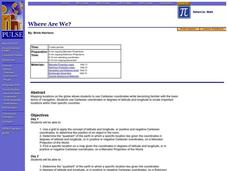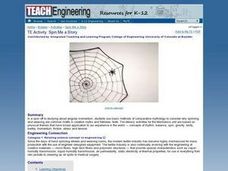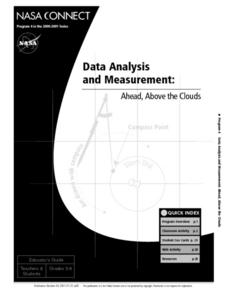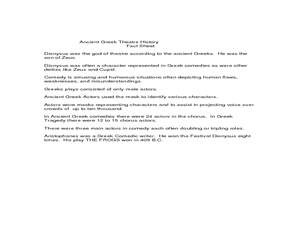Curated OER
Hatching Chicks to Agriculture - Where does the feed come from?
Second graders examine the types of grain that goes into feed for chickens. They study other grain crops grown in Kansas and the foods that are made from them.
Curated OER
Solid Waste and Recycling
In this unit of lessons, learners examine solid waste and recycling. They examine the relationship between Native Americans and land. They also decorate bags in which they discover the concept of decomposition.
Curated OER
LAB: Temperature Inversion - Pollution Simulation
Students, after identifying and examining the relationship of temperature and air masses in association with smog and pollution, create a temperature inversion in a long aquarium jar. They experience what happens when smog builds up and...
Curated OER
Indicator Species
Students explore the ecological foundation of India's and ways to save the forests, water and the India tiger. After a lecture on identifying a healthy forest and the importance of the animals, students participate in activities to...
Curated OER
Where Does Earth's Heat Come From?
Young scholars try to determine how the Earth is heated by the sun and other sources. In groups, they identify the other sources of energy and discover why different parts of the world are heated differently during the year. They...
Curated OER
How Does Temperature Vary Over Time?
Students examine the temperature flucuations on the Earth. After defining new vocabulary, they identify the flucuations of the Earth on a map. As a class, they develop a hypotheis on the temperature variation by examining the data.
National First Ladies' Library
World Starvation
Students investigate the concept of world starvation and some of the organizations that are founded in order to help solve the problem. They conduct research using a variety of resources. The information is used in order to conduct class...
Curated OER
A Sense of West Virginia
Students consider their perceptions of the world through their 5 senses while visiting the West Virginia State Museum. In this West Virginia history lesson, students discover how knowing about the past helps with their understanding of...
Curated OER
Infrared-Hot
Students describe how the sun heats the Earth, explain the nature of infrared light, explain how thunderstorms are formed and use infrared maps to predict severe weather.
Curated OER
Where Are We?
Students use Cartesian coordinates or degrees of latitude and longitude to locate important locations within their specific countries. They Use a grid to apply the concept of latitude and longitude, or positive and negative Cartesian...
Curated OER
African Safari
Seventh graders examine different countries in Africa to research. They choose one to concentrate their research on using the five themes of geography. They design a multimedia presentation that will make up the African safari.
Curated OER
Hurricane Frequency and Intensity
Students examine hurricanes. In this web-based meteorology lesson, students study the relationship between ocean temperature and hurricane intensity. They differentiate between intensity and frequency of hurricanes.
Curated OER
High Mountain Retreat
Learners explore and analyze atmospheric conditions for a high mountain retreat. They examine the relationship between altitude, atmospheric pressure, temperature and humidity at a particular location. In addition, they write reports...
Curated OER
By Land, Sea or Air
Learners learn navigational techniques change when people travel to different places. They understand differences between navigation on land, water, air and in space. They explain the concept of dead reckoning as it applies to...
Curated OER
U.S. Post Office Mural Walking Tour
Students discover a sense of community by examining Post Office murals located in cities and small towns throughout the United States. They explore the significance of the murals by contacting and communicating with local Postmasters....
Curated OER
Topos, Compasses, and Triangles, Oh My!
Students triangulate using a compass, topographical (topo) map and a view of outside landmarks. They take a field trip to another location away from school and mark discernible landmarks (like mountains or radio towers) and changes in...
Curated OER
Pandemic
Students examine contagious diseases. They explore different types of bacteria and the illnesses they cause.
Curated OER
Westward Expansion
Students explore the Westward Expansion Movement of U.S. history. In this Westward movement lesson, students use primary and secondary source documents research personal accounts of those who travelled west during the era....
Curated OER
Finding Satisfactory Solutions
Students decide where to locate ice cream stands in a town so that no one has to travel too far to buy a treat. The problem-solving strategies for this problem give students a chance to decide what makes a solution satisfactory.
Curated OER
Spin Me a Story
Students examine the motif of spinning and weaving in myths and folktales. They read various myths, complete a WebQuest, develop a mind map of story elements, and write an original "spider" story.
Curated OER
Healthy Eating
Students explore how they can make healthy food choices and assess how "eating healthy" requires knowledge and planning ahead. They review and discuss The Edible Pyramid as well before they complete this project online. Each student maps...
Curated OER
Data Analysis and Measurement: Ahead, Above the Clouds
Students explore and discuss hurricanes, and examine how meteorologists, weather officers, and NASA researchers use measurement and data analysis to predict severe weather. They plot points on coordinate map, classify hurricanes...
Curated OER
Dancing with Dionysus
Sixth graders research Ancient Greek culture by acting in a play for the festival of Dionysus. In this Greek culture lesson, 6th graders study an ancient Greek map and the Sarcophagus Dionysus from the Walters Art Museum website....
Curated OER
Life Cycle Of Stars
Students analyze characteristics that indicate human life cycles, and then apply these observational principles to various NASA pictures of stars to synthesize patterns of stellar life cycles. They observe NASA images of stars at various...

























